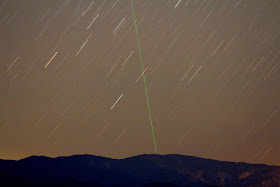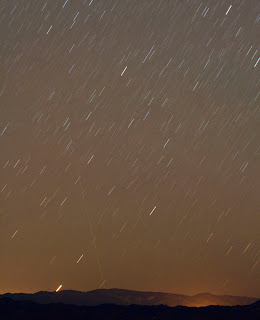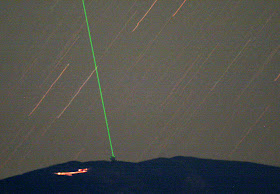ARGOS stands for the Advanced Rayleigh guided Ground layer adaptive Optics System. It is a method of correcting the distortions caused by turbulence in the atmosphere. If the star images can be made smaller by using these methods, you make them much brighter, allowing to see much fainter as well as finer structure in the image. A good introduction to this system is given on the ARGOS page of the Max Planck Institute.
 After seeing the above announcement on the LBT blog, I was wondering if the projected beams might be visible from the Tucson area, so last night Melinda and I went up to Mount Lemmon to San Pedro Vista where the LBT can be spotted at a distance just over 40 miles away. Sure enough, though not visible to the naked eye, in binoculars the beam could be seen against the sky! Over the course of 2 hours it varied in visibility, sometimes only barely visible in binoculars, but could be easily revealed in a few second exposure. Shown here is a 2 minute exposure with the 70-200 lens set to 70mm later in the evening. This approximates the view of the beam in binocs, and shows the bright Jupiter breaking the horizon just left of the LBT. From this vantage point LBT appears between the faint skyglow from the town of Safford, and a significant glow from Ft Grant, a prison and former army outpost just south of the Pinaleño Mountains. At right is a single 2 minute exposure with the lens set to 200mm. What looks like a single laser beam is, in fact, a set of 6 aligned beams from a Nd:YAG laser (neodymium-doped yttrium aluminum garnet) of 14-18 watts each...
After seeing the above announcement on the LBT blog, I was wondering if the projected beams might be visible from the Tucson area, so last night Melinda and I went up to Mount Lemmon to San Pedro Vista where the LBT can be spotted at a distance just over 40 miles away. Sure enough, though not visible to the naked eye, in binoculars the beam could be seen against the sky! Over the course of 2 hours it varied in visibility, sometimes only barely visible in binoculars, but could be easily revealed in a few second exposure. Shown here is a 2 minute exposure with the 70-200 lens set to 70mm later in the evening. This approximates the view of the beam in binocs, and shows the bright Jupiter breaking the horizon just left of the LBT. From this vantage point LBT appears between the faint skyglow from the town of Safford, and a significant glow from Ft Grant, a prison and former army outpost just south of the Pinaleño Mountains. At right is a single 2 minute exposure with the lens set to 200mm. What looks like a single laser beam is, in fact, a set of 6 aligned beams from a Nd:YAG laser (neodymium-doped yttrium aluminum garnet) of 14-18 watts each... While the blustery wind was evident on our drive up the mountain, the little saddle we were in was dead calm, though the wind was howling up in the treetops - weird! I wanted to set up a small telescope too, trying to catch more details of the telescope/laser. I have a small 80mm F/6 Meade APO refractor that works well for applications like this, so set it up on a substantial tripod. Another single 2 minute exposure is shown at left, along with the headlights of a car coming down the switchbacks of the one-lane dirt road on the last section of the Observatory road. Note the wiggles in the star trails due to turbulence at the low elevation, or the breeze wiggling the telescope - again, don't forget the LBT is over 40 miles away! In an attempt to reduce the speckles of this exposure, I tried stacking 3 exposures to smooth the electronic noise from the ISO 1600 used. At right is this exposure, but note that with the telescope tracking the sky, the laser moved between exposures! I was using in-camera noise reduction, so for every 2 minute exposure, it took a 2 minute dark, so in those 2 minutes it wasn't exposing, the laser moved to a slightly new position.
While the blustery wind was evident on our drive up the mountain, the little saddle we were in was dead calm, though the wind was howling up in the treetops - weird! I wanted to set up a small telescope too, trying to catch more details of the telescope/laser. I have a small 80mm F/6 Meade APO refractor that works well for applications like this, so set it up on a substantial tripod. Another single 2 minute exposure is shown at left, along with the headlights of a car coming down the switchbacks of the one-lane dirt road on the last section of the Observatory road. Note the wiggles in the star trails due to turbulence at the low elevation, or the breeze wiggling the telescope - again, don't forget the LBT is over 40 miles away! In an attempt to reduce the speckles of this exposure, I tried stacking 3 exposures to smooth the electronic noise from the ISO 1600 used. At right is this exposure, but note that with the telescope tracking the sky, the laser moved between exposures! I was using in-camera noise reduction, so for every 2 minute exposure, it took a 2 minute dark, so in those 2 minutes it wasn't exposing, the laser moved to a slightly new position.Unfortunately, after Friday night, ARGOS won't be on the telescope again until next Spring... I may need to make a trip to get another view of the Observatory from a closer vantage point tomorrow night!



No comments:
Post a Comment
We value your comments, but no spammers, please!